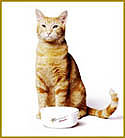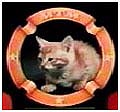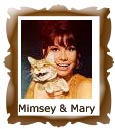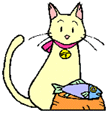Vol1 No24
Table of Contents
Assist Feeding – When and How to Ask for Help
Feline Nutrition – Designer Foods
Pro-Active Cat Care – Keeping It Simple
Feline Obesity – Time to Step Back and Punt
Kitty Potpourri – Morris & The Kitten That Roared!
Assist Feeding – When and How to Ask for Help
by Kathy FathereeI want to start off by saying. If you are syringe feeding your cat. I think that you are an absolute saint! The time and emotion involved with syringe feeding can be immensely draining! This is especially true if you are having a difficult time with the process. Many of my initial feeding sessions ended with me crying. Some kitties are easy to feed; others will fight you every time. If they do fight you, be thankful that they still have a fighting spirit. that’s for sure.How are the feedings going? Are your able to get the proper amount of food in your cat’s belly each day? I suggest that you keep some kind of log so that you can record the time that you fed, how much you fed, what you fed and any medications given. Tally up the mls that you fed each day so that you’ll know if you are meeting your goal. What if you don’t meet the daily required amount? Do you find yourself saying at the end of each day. “I’ll do better tomorrow.” If you do, then it is probably time to ask for help. It’s almost impossible to make up lost feedings since your kitty doesn’t feel like eating in the first place.I know that syringe feeding is a very personal thing and that many people don’t talk about it much less ask for help. Don’t be embarrassed or worry that someone will tell you that you are ridiculous for doing what you are doing. or that you have been doing it all wrong. or that you are a terrible person for letting your cat starve. (If someone is so rude as to say something like that, let it roll off your back and forget them!) Take action NOW! Get on the phone and start asking for help!First, call your vet, who more than likely knows that you are syringe feeding your cat anyway, and tell them that you need help. Know upfront that sometimes the vet doesn’t really know how to syringe feed! You may want to ask for “a technician who knows how to syringe feed and will show you how.” When you take your cat in, tell the vet tech that the goal of the session is to learn AND to get the full amount of food in for that session.
If your vet cannot provide you with quality help, they may tell you that your only option is to have a feeding tube surgically implanted. This will be something that you will need to discuss in detail with your vet. The main question to seriously talk about would be “Is my cat healthy enough to survive the operation?” You may choose NOT to have a tube implanted, either because of personal beliefs or because your kitty may not survive the operation, and that is perfectly fine.
However, do what it takes to find a way to syringe feed enough for your cat to gain health.Next, I would call rescue shelters and start asking the “Do you know anyone” question. Make a zillion phone calls and even ask cat people you meet on the Internet and try to find someone in your area to help you. If you are diligent with seeking help, you will more than likely find someone to help you.
Ask for help as soon as you know that your cat is not getting the right amount of nutrition. Weight loss is gradual and when you are with your kitty everyday and everynight, it is almost impossible to see the weight loss. We also go into denial and don’t really see what’s happening right before our eyes (that kitty is slowly starving.) Step forward and find the help that you need. It will be a blessing for both you and your kitty.
Feline Nutrition – Designer Foods
by Garry White
Let me pose a controversy that will probably generate some flak: Have we gone too far in the development of ‘niche’ foods for our cats? It doesn’t take much research to discover that the world of pet foods is mind-dizzying maze of options and choices. And while choice is a good thing, it seems that every week a new “discovery” is made, declaring that we must change Kitty’s diet right now. And I have to ask: Is this onslaught of new designer foods really intended to enhance pet wellness? Or is it commerce-driven, with goals to increase the bottom line.profits? My research into the world of feline nutrition leaves me with no firm answer to those questions. Certainly, feline medical research has leapt forward in the past few decades, and that’s to our benefit. Also, the veterinary world has come to realize that our furry friend isn’t “just a cat”. She’s as important to us as any other family member, we’re demanding more (and better) attention, and we’re getting it. But in that realm, are we being taken advantage of? Is the focus more on our emotions than on the pet? When my Lewie was ill, one clinic had him scheduled for nearly $4,000 worth of tests that were unrelated to his condition. When I challenged this, I was told: “.because it’s clinic policy, and this way we have the results if we ever need them.” Not so.most of those test results were valid for only a few days, maybe a week. Is that not capitalizing on our emotions? And how about this vast panorama of specialty foods; can we assume that many of them are nothing more than profit centers? I think so, in many cases. We see the ads with a beautiful, healthy feline specimen eating Acme Cat Food and loving it. It reminds me of Cindy Crawford sipping a can of diet soda.one can probably assume the soda isn’t what made her look that way. I ask again: Are we being taken advantage of? Are some of these marketers playing to our heart (and wallet), and not to Kitty’s best interest? Face it.we love those little beings, and when we’re confronted with “.This is the only food your kitty should be eating”, we listen. So what’s the gripe, you ask? Hey, we’ve got a lot more choices and that’s just wonderful! Right? Not necessarily. Yes, many of the new designer foods are based on extensive medical research, and they will help to maintain wellness. But let me tell you, my research has taken me into the bowels of some ingredient lists that border on the bizarre! Yet the claims are just as strong (and just as touching) as those of a bona fide manufacturer.
Okay, here’s the stickler: Whether a specialty food is developed by a major manufacturer, or whether it comes from a garage-kitchen in Toledo, we need to be sure it really is right for our kitty. We need to make sure the kitty will eat it, first of all, and we need to make sure it’s not depriving him/her of some crucial nutrient. In sum, we need to select with our head, not our heart.
ProActive Cat Care – Keeping It Simple
by Garry White
During the past months, we’ve discussed a number of proactive steps we might take to help assure long-term wellness and safety for our kitties. The range of topics has been broad, and the details within go almost to infinity. Watching for signs of ailments, for example: The field is nearly limitless, yet we as caregivers must always be on the alert. Problem is, most of us have busy, active lifestyles, and it’s easy to lose track of the details. But remember that the real story is in those details. Good proactive care is all about catching a problem or condition in its infancy, and the only way to do that is by tracking the details: Fur condition, weight, eating/drinking habits, litter box visits, stool color, demeanor, and a host of other “indicators” that we should be watching for. But as I said, it’s easy to forget what we last monitored, or when. So I’ll recommend a solution. In the world of industry, they call it PM.Preventive Maintenance. When the situation (equipment or environment) is crucial, routine inspections are done periodically, and the results are stored. Again periodically, someone reviews the results of those PM’s because, other than crash failures, a degrading situation shows up in the numbers. There’s no reliance upon someone’s memory, or someone’s opinion.the numbers tell you when something is going bad. Sounds pretty clinical, I know, but doctors and hospitals do the same thing with patient records. So.why shouldn’t we be following a proven method like this for our kitties? We should! I recommend a simple, uncomplicated system that highlights the areas we want to keep track of (as mentioned above, and others). Make sure there’s a place for dates when you last monitored a particular issue or activity, a place for the results, and then store the whole thing in Kitty’s binder. Or if you happen to be computer-handy, a spreadsheet would work well. And once a week.without fail.sit down for a few minutes with that binder or spreadsheet. Make appropriate entries for things you’ve noted during the week, and by all means scan the other entries. We’re looking for trends – a “2” that seems to showing up as a “3” more frequently, that sort of thing.
This means, of course, that we’re setting enough time aside to monitor things in the first place. For example: Seeing your kitty in the litter box is not information, and it confirms nothing. Tracking her litter box activity for a day, maybe once a month, is information. We check for stool color and consistency, approximate amount of urine, and whether or not she’s struggling with either function; these things are information. The same thing holds true for the many other “indicators” we’ve outlined in previous Newsletters: Monitor, Record, Review. This simple process (good record-keeping) could easily stop a crisis from ever happening.
Feline Obesity – Time to Step Back and Punt
by Kathy Fatheree
Not your cat. the cat food! Whew. ok there. Some of you had me worried. (and you know who I’m talking about!)Is your cat on a diet? I mean a real diet where you monitor food intake and have weigh-ins once a week? Has kitty lost weight? If not, it may be time to re-examine the food. You may have the best diet food your vet carries and if it’s not working. it’s not working. It all comes down to whether or not the food is right for your kitty.When I had Bubba on a diet food, he was ravenous and actually gained weight! It wasn’t until I threw my hands up in frustration and started letting him graze all day on his diet food that he actually lost weigh! Now I’m not promoting grazing. what I’m actually trying to say is that your cat may not be getting the nutrients he or she needs from the diet food. In Bubba’s case, he wasn’t getting enough of something until I let him eat all he wanted. then his body finally allowed him to shed some weight. I regret all those years that I deprived him of the complete nutrition he craved. After I determined what the problem was, I switched him to a non-diet food and monitored his daily intake and he did just fine. Just as there are many kitty personalities, there is a wide variety of nutritional needs. A good diet food for one cat isn’t necessarily a good diet food for your kitty.Give each diet food you try a solid effort for at least 2 months. Don’t switch after a few weeks or a month thinking the food isn’t working. Sometimes it takes a while for the body to let go of that fat. But after a few months, if your cat has not lost or even gained. it’s time to switch to something new!What’s the best food for your cat? It really depends on his or her nutritional needs. Every cat is different. Genetics may come into play as well. You know those people who can eat anything and never gain a pound! Our Garry has found a new food that we are going to research. It’s a holistic food with natural ingredients. It NOT a diet food, but if the meal portions can be controlled, your cat may not need a diet food. This food that we are going to research is called Solid Gold. If you’ve tried it… let us know! They only have one canned food on their web site, but Garry found out that they are coming out with a second variety. We will follow up on this and let you know.
Bottom line, if your cat isn’t losing weight on your current diet food, find a new food, gradually switch your cat over, and try it for a few months. Remember to transition to the new food over about a week’s time by mixing more and more of the new food into your current food. Don’t run the risk of digestive upset by switching too fast!
Kitty Potpourri – Morris & The Kitten That Roared!
by Dan Malenski
This week, let’s talk about cats who achieved fame because of their own personalities, not due to “owning” a famous human being. Of course. the most famous cat, however, is the one that is probably sitting in your lap, purring like a jet engine, or perhaps performing household chores such as “fixing” your curtains. The girls helped me with my research on the Internet and we turned up lots of interesting things about Morris®, the famous orange tabby and the MTM® kitten.Everyone who has not been living on Mars for the last several decades knows Morris®, the famous orange tabby spokespurr-son for 9 Lives® cat food, but how many know much else about him, aside from the fact that nearly half of the orange tabby males on earth are named after him?Morris® was discovered in a Chicago Animal Shelter by  professional animal handler Bob Martwick in 1968 and Morris started his meteoric rise to stardom… and just in the nick of time, being that he was scheduled to be euthanized within the hour! His first task was to take over the role of spokespurr-son for 9 Lives® cat food. Over the years, in addition to pitching 9 Lives® cat food, he starred in movies, wrote books, and was invited to co-sign (with a paw print) the National Animal Protection Bill by President Richard M. Nixon. He also has been responsible for giving needy animal shelters with millions of dollars worth of cat food and outright donations. In 1988 and again in 1992, he entered the race for President of the United States, achieving greater name recognition than all candidates expect the existing President, George H. W. Bush. Listing all his numerous contributions to society, particularly to the animal kingdom, is far beyond the scope of this article. You may view the complete biography and story of Morris® at his official web site. Click HERE for a details of Morris’ Biography and Story.Next in line is the MTM® kitten! How many thought that
professional animal handler Bob Martwick in 1968 and Morris started his meteoric rise to stardom… and just in the nick of time, being that he was scheduled to be euthanized within the hour! His first task was to take over the role of spokespurr-son for 9 Lives® cat food. Over the years, in addition to pitching 9 Lives® cat food, he starred in movies, wrote books, and was invited to co-sign (with a paw print) the National Animal Protection Bill by President Richard M. Nixon. He also has been responsible for giving needy animal shelters with millions of dollars worth of cat food and outright donations. In 1988 and again in 1992, he entered the race for President of the United States, achieving greater name recognition than all candidates expect the existing President, George H. W. Bush. Listing all his numerous contributions to society, particularly to the animal kingdom, is far beyond the scope of this article. You may view the complete biography and story of Morris® at his official web site. Click HERE for a details of Morris’ Biography and Story.Next in line is the MTM® kitten! How many thought that the MTM® kitten, seen at the end of many popular television shows was just a spin-off of the lion mascot for Metro Goldwyn Mayer films–shame on you if you did! The MTM® (Mary Tyler Moore Enterprises Inc.) kitten was a real kitten named Mimsey, rescued from a local animal shelter in 1968 when a mascot was being sought for MTM. After joining MTM, she soon was known as the “kitten that would roar” and appeared at the end of each show, at which time, she would utter a sweet and short “Meow”. The photo shows her adorning the MTM® logo as it appeared at the end of most shows. If you wish to refresh your memory of her by listening to her “Meow”, you may do so by clicking on the following link and then selecting MTMKitten.WAV among the others on the window. Click HERE to listen to Mimsey’s “Meow” at the Mary Tyler Moroe Show Sound Directory! On some shows, Mimsey would take on a characteristic of the show. For example, she would wear a police officer’s hat for a police show (Hill Street Blues), a surgical mask for a hospital show (St. Elsewhere), and a Sherlock Holmes hat for a detective show
the MTM® kitten, seen at the end of many popular television shows was just a spin-off of the lion mascot for Metro Goldwyn Mayer films–shame on you if you did! The MTM® (Mary Tyler Moore Enterprises Inc.) kitten was a real kitten named Mimsey, rescued from a local animal shelter in 1968 when a mascot was being sought for MTM. After joining MTM, she soon was known as the “kitten that would roar” and appeared at the end of each show, at which time, she would utter a sweet and short “Meow”. The photo shows her adorning the MTM® logo as it appeared at the end of most shows. If you wish to refresh your memory of her by listening to her “Meow”, you may do so by clicking on the following link and then selecting MTMKitten.WAV among the others on the window. Click HERE to listen to Mimsey’s “Meow” at the Mary Tyler Moroe Show Sound Directory! On some shows, Mimsey would take on a characteristic of the show. For example, she would wear a police officer’s hat for a police show (Hill Street Blues), a surgical mask for a hospital show (St. Elsewhere), and a Sherlock Holmes hat for a detective show  (Remington Steele). Mimsey lived a full and productivelife, and after she retired from show business, she spent the remainder of her life with a MTM® staffer.
(Remington Steele). Mimsey lived a full and productivelife, and after she retired from show business, she spent the remainder of her life with a MTM® staffer.
This photo shows her with
Mary Tyler Moore.
Extra Bonus! Do you use Outlook Express (Windows) for your email client? If so, would you like new mail arriving to be announced with a cheerful “Meow” instead of the terribly sounding default in Windows XP? My technical adviser, Melissa, tells me that replacing the sound with one of your choice takes just a few seconds and is a standard option of Windows. Of course It would not be proper to use Mimsey’s “Meow”, but using one made from one of your kitties would be just fine. If you are interested in knowing how to do this, just write, and I will ask Melissa to provide you with the details.
Email Dan and Melissa at: daniel.malenski (at) verizon.net
Disclaimer: Kathy Fatheree is not at all a medical expert. Contents of this web site are a collection of Kathy’s assist feeding experiences as well as the experiences of other cat owners who have assist fed their cats. While every effort has been made to ensure the accuracy of the information, Kathy Fatheree or anyone associated with this web site cannot be held responsible for anything that may happen as a result of using the information on this site.
